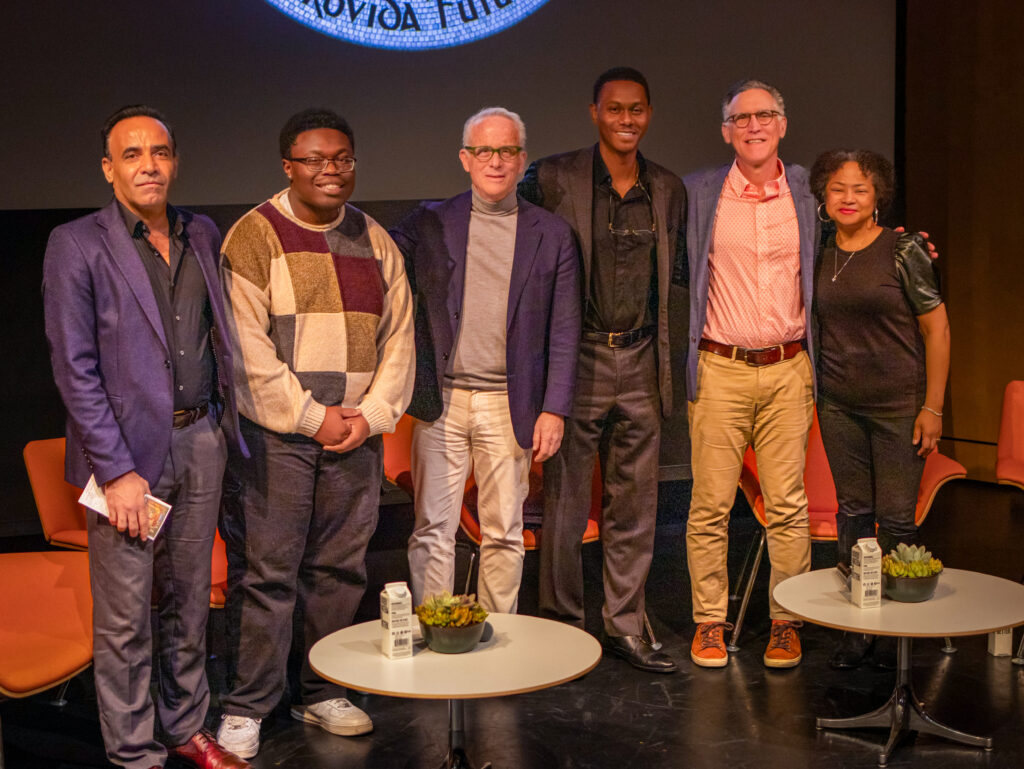 The Barber of Little Rock screening and discussion participants (from left): Racial Justice Initiative Director and Professor Ahmed Alwishah, William Marshall ’25, filmmaker John Hoffman, community bank founder Arlo Washington, Pitzer President Strom Thacker, and Pitzer Vice President for Student Affairs Jan Barker Alexander. (Photo: Miranda Yee ’27)
The Barber of Little Rock screening and discussion participants (from left): Racial Justice Initiative Director and Professor Ahmed Alwishah, William Marshall ’25, filmmaker John Hoffman, community bank founder Arlo Washington, Pitzer President Strom Thacker, and Pitzer Vice President for Student Affairs Jan Barker Alexander. (Photo: Miranda Yee ’27)
The Barber of Little Rock presents an intimate picture of the racial wealth gap in the community of Arlo Washington, a barber in Little Rock, Arkansas, whose vision of a just economy led him to create a nonprofit community bank.
Earlier this week the Pitzer community welcomed Washington and John Hoffman, one of the film’s directors, for a special screening and discussion of the film, which has been nominated for a 2024 Academy Award.
Co-sponsored by the Presidential Initiative on Constructive Dialogue and the Melvin L. Oliver Racial Justice Initiative (RJI), the event featured a post-screening discussion with Hoffman, Washington, RJI Director and Professor Ahmed Alwishah, William Marshall ’25, and Vice President for Student Affairs Jan Barker Alexander, who moderated the discussion.
The film, which is part of The New Yorker Documentary Series and can be viewed online, is a poignant call for more private sector action and more efforts to help marginalized populations overcome the financial obstacles that impede their pursuit of the American Dream.
“Sadly, ‘banking while Black’ is a real thing,” says one of the people whom Hoffman and co-director Christine Turner interviewed in their film. “You come in [to a bank] and you’re Black, and there are no services offered.”
The lack of services and frustration at not being seen as credit-worthy have forced many in Washington’s Little Rock community to find ways to enjoy their lives and find opportunities without the support of financial institutions.
Hoffman and Turner chronicle how Washington confronted this situation and developed People Trust, the sole bank within a 10-mile radius to give economic support to the area’s underserved and underbanked residents. Washington was able to create the bank with the support of the Community Development Financial Institutions (CDFI) Fund, a program to help revitalize distressed communities that was started during the Clinton Administration.
Asked what attracted him and Turner to telling Washington’s story, Hoffman explained that they wanted to embed with a Black-owned CDFI and discovered Washington in the course of their research.
“Once you start looking,” Hoffman said, “you find that there is a very rich world of people, of other Arlos out there, who are creating these important parts of communities.”
At first, Washington was hesitant about the filmmakers’ proposal to make a documentary about him and the bank.
“It was something we really had to think about. We didn’t want to be out there exploiting our community members,” he explained. “John and Christine and the whole team did an excellent job of making us feel comfortable, of establishing that level of trust and keeping the integrity level really high. I’m glad we got a chance to share. I’m happy that it’s had an impact.”
Alwishah expressed admiration for Washington’s analogizing of capital with blood to stress why Black communities critically need the same financial opportunities that others receive; Maxwell praised the filmmakers for their storytelling.
“You could have chosen anyone in the world to talk about, but because you were following someone so deeply entrenched in a community who is righting wrongs and giving a platform to those who need it most, that’s what gives this film such a strong foundation and that deserves so much respect and recognition,” he said.
Near the end of the discussion, Washington reflected on the policies of neglect and exclusion facing his community and many others and what this means for their belief in the American Dream. The solution is simple, he said. The answer is based on one word: opportunity.
“At the beginning of the film, as you see on the screen, I say it’s about having an opportunity, a real opportunity,” he said. “That’s what the American Dream is to me: actually getting a real chance at creating the opportunity for yourself and those around you.”